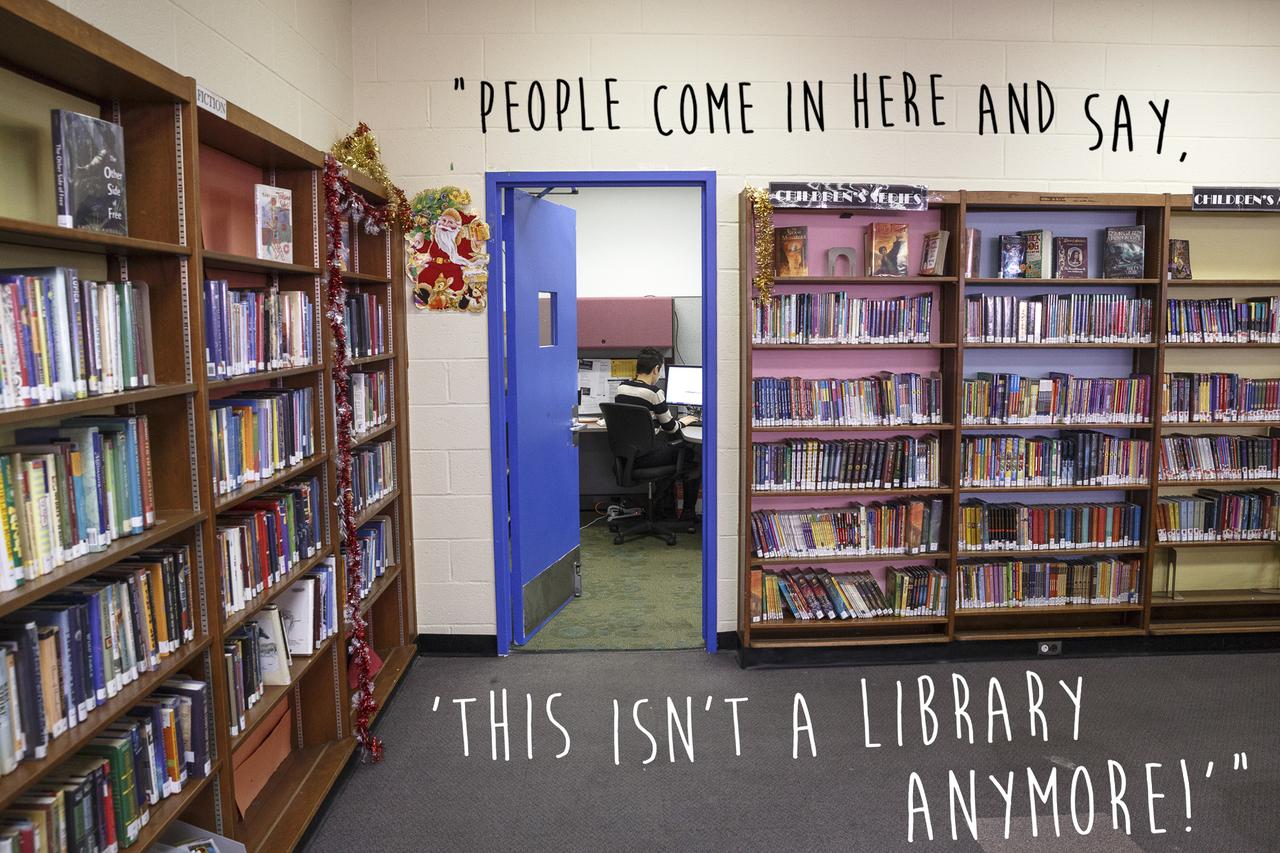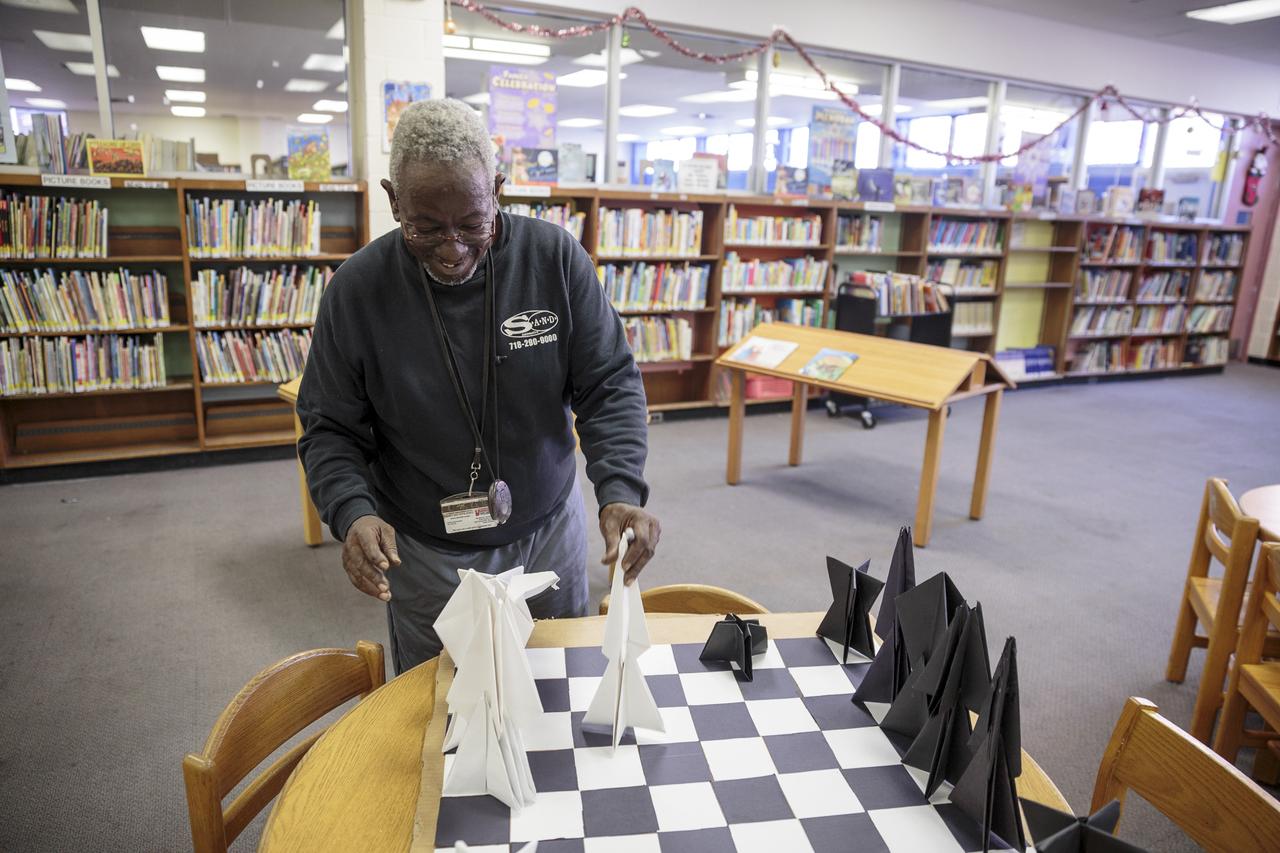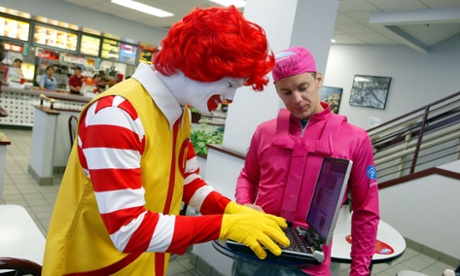by: Katie Gilbert
Harlem Shake in a library? Yes!” cries the caption of a YouTube video uploaded
this spring by the regulars of the Queens Library for Teens.
The Harlem Shake at the Queens Library for
Teens.
While watching dozens of
teenagers decked out in parrot masks and Bugs Bunny costumes dancing, jumping
and spinning on rolling chairs across the frame, anyone is likely to wonder:
This was allowed in a library? And upon entering the space where the
clip was filmed, many people do ask: This is a library? Aside from a
few small shelves of test-prep materials, this 3,000-square-foot room holds no
books.
The teen library sits at
the corner of Cornaga Avenue and Beach 20th Street in Far Rockaway. It opened in
a former retail space in 2007 to resolve the mounting complaints from patrons at
the Far Rockaway library branch a block away, who grumbled that the horde of
teens descending on the facility every day after school was just too disruptive.
The teen library is open from two-thirty p.m. to six p.m. Monday through Friday
and admits only twelve- to nineteen-year-olds—not their younger siblings, and
not even their parents.
Kim McNeil Capers, the
teen library’s director, laughs when she says, “Kids don’t come in here to find
books. They come here to find a girlfriend!” That’s only partially true. Capers
is a certified mental health counselor, and before she joined the library she
supervised mental health programs for teens and children. Her face straightens
when she adds: “When they come in here, we’re going to get them the help they
need.”
![]()
It’s a common refrain
among those working in New York’s public libraries these days: Because it’s
increasingly difficult to pin down exactly what kind of help they’re supposed to
offer, librarians have tried to make their mission pliable, and to offer
whatever help people need, in whatever realm it may be. They’re hardly limiting
their offerings to intellectual pursuits.
In fact, no librarians
work at the teen library—youth counselors run the place. And though it’s devoid
of books, the room holds plenty else. After the orange-sherbet walls, the rows
of forty computers are likely to be the first thing you notice. On the opposite
wall, magazine racks house seventy subscriptions, and interspersed with those
are salmon-and-green padded chairs. Upon entering one recent afternoon, a group
of about ten boys immediately pulled them into a circle to facilitate their
noisy Yu-Gi-Oh! trading card game.
When you get to the back
of the room, you’ll come upon the teens’ most prized possession: a $70,000
recording studio, flanked by three editing stations. To one side of that is the
gaming lounge, and to the other side a pool table, which will soon shift roles
to serve as the foundation for a model town with a working model railroad. When
the teens start to stream in, the air swells with friendly yelling, B.O. and the
scent of fast food, but they aren’t chided for shouting or snacking. This is a
place for hanging out.
![]()
However, what the teen
library hopes to offer its young patrons is heftier than that. Far Rockaway
struggles with high unemployment and the social issues common to areas with many
low-income housing projects—problems that have only been compounded by the
neighborhood’s isolated location on a remote barrier beach, not to mention
Hurricane Sandy, which came through in 2012.
The teen library’s daily
and monthly programs are tailored to this vulnerable population, hosting daily
GED prep classes, an annual college fair, health classes, gang awareness
programs, a chess club, CPR training, a Regents Exam prep club, a streaming
radio station via the recording studio, an annual science fair, and scores of
other activities.
The Queens Library for
Teens is a reflection of what New York City’s libraries have come to believe
about themselves: They are in a position to do more than just connect their
patrons to books and content.
* * *
What is a library
for?
That question has never
been as difficult to answer as it is today. Just as the Internet has given way
to identity crises within journalism, publishing, and music, movie and
television distribution, it has also confused what used to be libraries’ central
purpose: providing a singular portal to content for whomever cared to access it.
With the World Wide Web blowing in and demanding recognition as the more
singular portal to the world’s content, libraries’ painstaking cataloguing of
information that is now largely Google-able is looking a bit less critical.
It’s an upheaval that
calls for a more existential grappling than can be addressed by digitizing
library content or installing rows and rows of new computers. Librarians have
had to delve deeper and ask themselves fundamental questions about their role,
such as, what can they offer that the Internet can’t?
“Libraries are
aggressively moving into a range of services that aren’t necessarily related to
book lending,” says Lee Rainie, director of the Pew Research Center’s Internet
Project, a nonprofit research body that has published a series of reports about
how technology is changing expectations of library offerings. “They are pretty
radically rethinking their mission in the world,” he said.
Major cities like New
York may be the most progressive incubators for the trend. Rainie adds, “There’s
clearly something special that has happened in urban libraries, where they are
thinking very seriously about the new services mix that they should offer to
their patrons.”
Library employees from
each of New York City’s three systems—New York Public Library (with branches in
Manhattan, Staten Island and the Bronx), Queens Borough Public Library, and
Brooklyn Public Library—maintain that their institutions are in the midst of a
role reappraisal.
“We’re evolving our
service model,” says Thomas Galante, president and C.E.O. of the Queens Borough
Public Library. He points to shifting budget priorities to illustrate. For
example, when the libraries suffered deep funding slashes in the early 1990s and
again in 2001, Galante and his colleagues delegated cuts based on where they’d
have the least impact on circulation. Library locations with the most in-and-out
book traffic stayed open six days a week, while those with more anemic
circulations only opened their doors two or three.
But by the time
libraries saw funding pull back again in 2008, priorities had reversed. The
system’s directors wanted to ensure that each of its sixty-two branches would
open at least five days a week, so the books budget bore the brunt of the
cutbacks as it was snipped in half.
“We know there are all
sorts of other reasons why people walk through our doors—for programs, for
computer access, for a place to get out of the heat,” Galante says. “We thought
that was more important than having twice as many new books on the shelves.”
Brooklyn Public Library
chief librarian Richard Reyes-Gavilan notes similar changes pervading his
system. “I’d love to say we’ve made this conscious decision to sort of
reevaluate our role in people’s lives, but really all we’re doing is responding
to community needs,” he says. “Our physical spaces are situated across the
borough to deliver informal, nontraditional educational experiences, and that’s
what we’re really moving into.”
![]()
Reyes-Gavilan explains
that when making hiring decisions, “we’re not necessarily asking people anymore,
'Tell us what experience you’ve had with reader advisory or cataloguing.’”
Instead, he asserts, the system’s higher-ups are more apt to value experience in
education or social services.
All three of New York
City’s library systems are in the process of building out new departments and
positions that more readily evoke a social worker’s job description than that of
a traditional librarian. In September, BPL launched its new Outreach Services
Department, which will eventually consist of five full-time staff members tasked
with expanding services for immigrants, senior citizens and prison populations.
In October, NYPL began hiring for the new role of “intake managers,” library
employees who will help patrons sift through the growing number of programs, and
who will maintain a hands-on role after doing so, contacting patrons when, for
example, they miss classes for which they’ve registered. For its part, the
Queens system has six full-time and two part-time case managers—all hired since
2009—who help visitors navigate the murky waters of government programs and
services.
In the decade between
2002 and 2011, the number of programs offered across the city’s 206 branches
jumped twenty-four percent, and the number of attendees at those programs shot
up by forty percent, to 2.3 million, according to a Center for an Urban Future
report.
These changes are making
for an altogether different library experience. Galante says they have
designated quiet rooms recently because “the rest of the library isn’t as
quiet.”
“People tend to think of
the libraries they grew up in,” he adds. “But those are very different than
walking into a public library today.”
* * *
Over the past five
years, Madlyn Schneider has helped transform Mail-A-Book—a library program based
in the Queens Village branch that delivers books and other materials to New
Yorkers unable to leave their homes because of age or disability—from a
straightforward delivery service into the teleconferenced social life of dozens
of Queens’ homebound residents.
Bonnie Sue Pokorny was
just looking for something to read when she first contacted Mail-A-Book in the
early 1990s. At that time, Pokorny, now sixty-eight, had recently been diagnosed
with a rare neurological autoimmune disorder that came on quickly and brought
with it frequent bouts of dizziness, fainting and overheating. She had always
been active and independent; she’d raised three children by herself, worked full
time managing the claims department of an insurance brokerage house in Nassau
County, and ran a large late-summer street festival in Queens for thirteen
years. But when her illness hit, it cost her almost more effort than she could
bear just to sit up. Her doctors told her she’d never work or drive again.
But she had always been
an avid reader, and at least that was something she wouldn’t have to relinquish.
She learned that Mail-A-Book could help with that, and for the majority of the
intervening twenty-three years she’s been bound to her Forest Hills apartment,
it has.
But things started to
change for Pokorny when Schneider took over Mail-A-Book in 2008. Schneider had
previously worked in an administrative role at the library, which required her
to spend hours sitting in boardrooms on conference calls and staring at Polycom
teleconferencing technology in the center of the room. In her new role, she
started to wonder: What else might the library be able to do for the roughly
four hundred socially isolated patrons receiving book deliveries from her staff?
She applied for a small grant from the Harry and Jeanette Weinberg Foundation
and used it to purchase teleconferencing equipment. The library system agreed to
foot the monthly bills for an 800 number.
At first, the
Mail-A-Book teleconference chats happened only on Friday mornings, and were
strictly book-related. Mail-A-Book users could call the 800 number to chat with
other patrons about the books they’d read that week. As demand grew, the library
added a Tuesday afternoon session. As New Year’s Eve approached, a woman on one
of the calls complained that she dreaded the holiday for how lonely it made her
feel—a sentiment shared by many on the call. So Schneider convened a telephonic
New Year’s Eve gathering from home that year, and another the next day.
Schneider kept coming up
with new possibilities for the library teleconferences: art lectures from
docents at the Metropolitan Museum of Art and the Museum of Modern Art;
collaborating on crossword puzzles via Skype; performances over the phone from
musicians and comedians; emailed newsletters with patrons’ own art, poetry,
recipes and book reviews; and, eventually, occasional in-person lunches in
Queens diners for those Mail-A-Book members who could venture out.
![]()
Over the past few years,
Pokorny’s phone-based social world has ratcheted to a level that might be more
normal for a patron of the teen library—her Mail-A-Book commitments generally
call for her several times a day. “Before, I was always trying to make sure I
had a lot of projects in the house to keep busy, so the four walls weren’t
climbing on me,” she says. “Now I don’t have time for my own projects. There’s
always something going on.”
Pokorny got something
else out of Mail-A-Book she hadn’t expected the program could provide: a new
friend. She was introduced to Margo during a Mail-A-Book teleconference, and
although they never met in person, the two of them were soon calling each other
up three or four times a day. They took online classes together that they’d
learned about through Mail-A-Book, and helped one another with the homework. “We
had the same sense of humor, the same interests,” Pokorny says. “A lot of our
experiences were similar.”
Margo passed away last
December at seventy-seven.
“We became very, very
close,” Pokorny says. “I had Margo in my life for maybe a year and a half before
she died. I consider that year and a half very lucky, because you don’t make
friends when you’re homebound. You might have acquaintances, but Margo and I
were fast friends.”
Today, Pokorny is more
tied up than ever in Mail-A-Book, and at this point, most of the services she
receives from the library have little to do with books.
“With all the activities
in Mail-A-Book,” she says, “I don’t have time to read.”
* * *
The consensus among New
York City library employees about what exactly has happened within their
institutions over the past decade starts to crumble when they acknowledge that
the library is no longer the book-and-reading-centered body it used to be.
What, then, is the
library becoming? QPL’s Galante rejects the suggestion that his libraries are
becoming indistinguishable from social service agencies.
“People come to the
library today to find a new job, learn a skill, take a GED class. These are all
things that someone could dub as social services, but they’re not,” Galante
says. “A public library today has information to improve people’s lives. We are
an enabler; we are a connector. When it comes to social services, a lot of what
we do is help people by referring them to places they can go.”
Sandra Michele Echols,
interim manager for QPL’s adult literacy program, is of another opinion. She’s
in the midst of writing an article about the direction public libraries are
headed, and its working title aptly summarizes where she stands: “I Could Tell
You Stories: Am I a Librarian or a Social Services Manager?”
Echols joined QPL in
2009 as the system’s first case manager, screening and referring library patrons
to nonprofits and government organizations that could help meet their needs. She
says the role of a designated case manager had been made necessary by the
passage of the
E-Government Act of 2002, a federal law that sought to allow
citizens access to a wide range of government information and services via the
Internet. The act was widely hailed as a boon to the working class, who’d now be
less likely to have to miss a day of work for a visit to the DMV. But others,
including Echols, complain that an unintended consequence of the act was that it
put significant pressure on public libraries—particularly in a place like New
York City, where, as
a report from Comptroller John Liu’s office noted in April,
nearly a quarter of households don’t have a computer.
“Now that the
E-Government Act has been passed, it helps the working class do things really
easily, but it alienated the poor and furthered the digital divide,” Echols
says. “And now, social service agencies are telling individuals, ‘Go to your
public library and have them help you print out your child support, or the
application for housing.’ So that’s becoming a real specialty for
librarians.”
The Far Rockaway branch
brought in a case manager who set up her own office in the library building in
early November. Sharon Anderson, the branch manager since 2008, says she had
become so overwhelmed with requests for help filling out government forms,
assisting with job applications, calling battered women’s shelters, and, in one
case, finding a rape hotline, that it became necessary to situate a case manager
in the building.
Anderson’s branch
doesn’t exactly greet its visitors with the enforced hush most expect of a
library, but it doesn’t shriek with chaos, either. The buzz of activity falls
somewhere in between—it’s the sound of a space being utilized in layers.
Bookshelves line the perimeter of the 6,300-square-foot library, allowing ample
room for about twenty computers (all in use on a recent weekday afternoon); a
set of gleaming white cubicles that house the Workforce1 Career Center, a job
placement service run by the NYC Department of Small Business Services; a kiosk
with information about the branch’s new Google Tablet lending program; and
several tables where dozens of students cluster each afternoon for an
after-school tutoring program funded by the U.S. Department of Education’s 21st
Century Community Learning Centers initiative.
“People walk in here and
say, ‘This isn’t a library anymore!’ Well, you know what’s funny?” Anderson
says, pausing to laugh. “It’s really not!”
She says that sometimes
people complain about the level of activity in the building, but she hasn’t been
surprised to discover that much of her job description requires her to raise her
voice above a whisper.
When Anderson earned her
master’s degree in library science from Queens College in 2004, she presented
her thesis on what she saw to be a blurring line between librarians and social
workers. “I started to see an evolution where librarians were getting away from
sitting at a desk and checking out books,” she says. “I knew I was going to be
taking on more of a social services role.”
![]()
As we talk, a woman in a
red sweater and Iris Apfel glasses approaches Anderson’s desk and, pointing her
cane in the direction of the street, complains that she’s been wrongfully stuck
with a parking ticket. Anderson listens, then explains how the woman can contest
the ticket by mail.
When the woman walks
away, Anderson says she believes the changes in her library have been driven by
“too many social issues and not enough social agencies,” combined with her
institution’s broad mandate and its eagerness to adapt. “Part of our mission is
to help people,” she says. “We’re just responding to the environment, and
continuing to say, ‘Whatever your needs are, we’ll help you.’”
Of course, changes
within libraries aren’t met with blanket acceptance. In a Pew Research Center
survey of Americans’ expectations of libraries in the coming years, respondents
were generally supportive of new technologies, apps and lending programs, but
they weren’t sold on the idea that “libraries should move some printed books and
stacks out of public locations to free up space for tech centers, reading rooms,
meeting rooms, and cultural events.” Thirty-six percent of respondents said
libraries should “definitely not” push books aside for these other types of
programs, while thirty-nine percent answered that “maybe” they should. Only
twenty percent were “definitely” on board with such changes.
Little surprise, then,
that NYPL kicked up such fervent controversy when it announced its plans to
renovate its flagship research library, the lion-guarded Stephen A. Schwarzman
Building on Forty-Second Street. The plans are Pew’s hypothetical made literal:
in order to combine services from the Mid-Manhattan Library and the Science,
Industry and Business Library into the building, books and other research
materials will be shipped to a storage facility in Princeton, N.J., to make way
for not only a new circulating library, but additional computers, group work
spaces, an expanded children’s room with new programming, and the building’s
first-ever teen room.
![]()
“Will Forty-Second
Street remain a serene environment for scholars, serious readers, intellectuals
and book lovers, or will it be converted into a noisy, tumultuous branch
library?” Scott Sherman wondered
in The Nation, in one of a series of articles that criticized the
renovation plans.
John Lundquist, a former
chief librarian of the NYPL’s Asian and Middle Eastern Division, was forced to
retire in 2009, a year after the division was closed. Lundquist is concerned
about the main branch’s renovation plans, but he stresses that he draws a strong
distinction between the mandate of the city’s research libraries and its branch
libraries.
“I feel that the branch
libraries, and public libraries in general, are totally right to go in
directions [in which they assume a] much broader social mandate,” he says. But
the changes shouldn’t extend to research libraries, he says. The relocating of
research collections to make way for other types of library spaces constitutes,
he believes, “the tragedy of the dumbing-down of the research collections of
NYPL.”
* * *
It’s the Monday evening
before Thanksgiving, and the Far Rockaway branch is throwing a party. The tables
that would have otherwise been host to after-school tutoring are pushed out of
the way to make room for a few dozen chairs facing a makeshift stage where
one-man-band Peter J. LaRosa regales the crowd of roughly fifty with big-band
classics.
Behind the chairs where
concertgoers sit, a line of volunteers scoop steamed vegetables, mashed potatoes
and gravy, stuffing, and turkey out of tinfoil pans onto the line of plates
moving past.
Two middle-age women in
the audience, Shirley and Debbie (both declined to share their last names), have
come to the library to see LaRosa, whom they once saw perform at a nursing home.
They marvel that such a noisy event would be held in a library.
“I’m surprised they’d
allow food in here with the books!” Shirley says.
Debbie nods in the
direction of a group of youngsters jump-dancing to a Tony Bennett tune and
chortles. “These kids don’t look like they’ll be looking at books after
this.”
A woman shrouded in long
dark hair, sunglasses, and wine-colored lipstick chimes in, telling me about the
free jewelry classes she took at this library branch the week before. “And it’s
not with the plastic stuff—they give you nice stones,” she says. “And you get to
keep it.” She adds that the library’s programs are good for Far Rockaway. “Thank
goodness they think of this stuff, because there’s not a whole lot else out
here.”
But, she adds—and now
she’s shouting to be heard over a tangle of teenagers wrestling over a cell
phone—she misses having a quiet library where she can just go to read.
So what’s more
important, I ask: A library that excels in the programs, or one that has
mastered the quiet?
“Both,” she says,
without missing a beat. “A library should be both.”
* * *
Katie
Gilbert is a freelance writer based in New York City. She has written
for TheAtlantic.com, Psychology Today, Institutional Investor, Willamette Week,
and others.
from:
Narratively






















